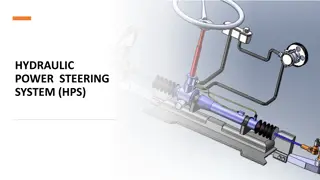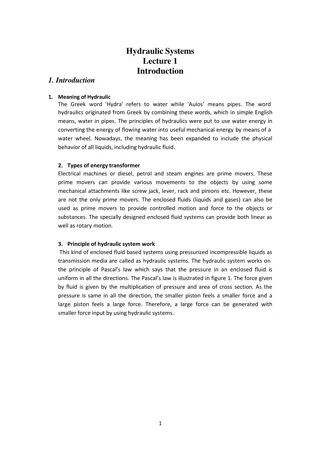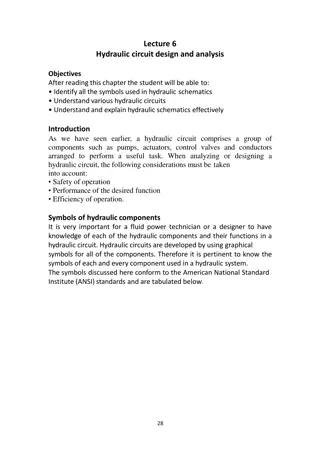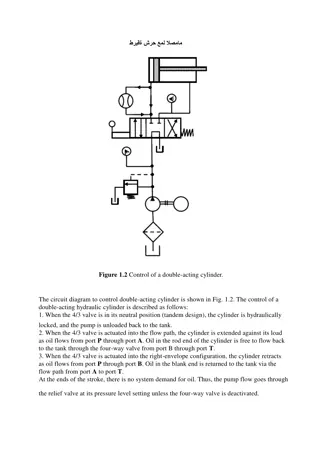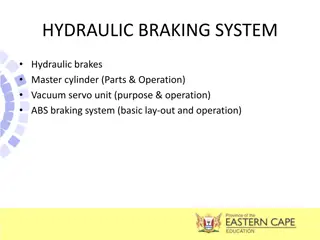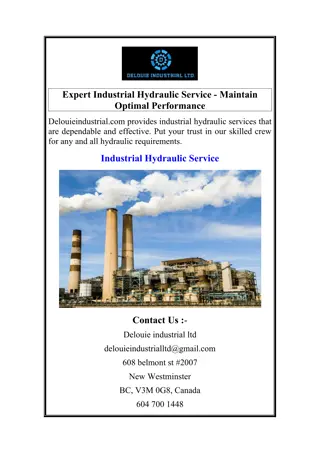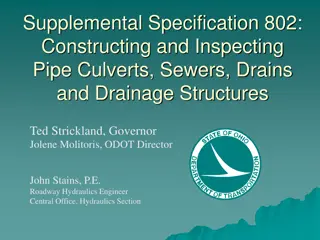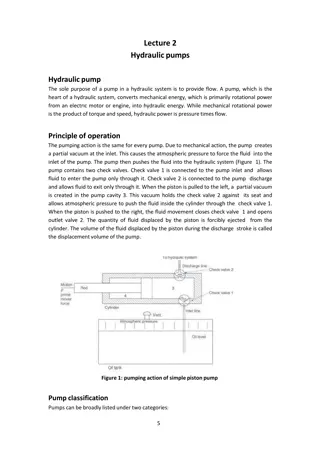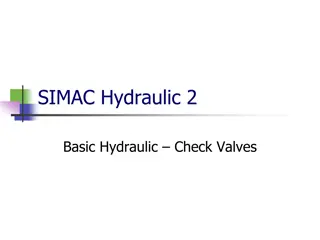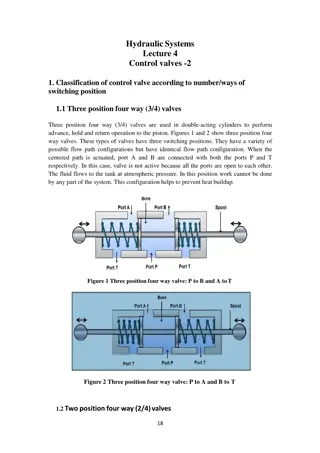Understanding Hydraulic Design of Sewers: A Comprehensive Overview
Delve into the world of hydraulic design of sewers with expert Geremew Sahilu (PhD). Explore historical perspectives, principles of sanitation, sewage collection and conveyance, wastewater flow rates, sewer design, various appurtenances, pumps, natural wastewater disposal methods, treatments, and essential hydraulic formulae such as Chezy’s Formula and Kutter's Formula for sewer velocity determination. Gain insights into designing sewers for gravity flow, understanding hydraulic properties, and the significance of gradient and particle settlement to prevent blockages.
Download Presentation

Please find below an Image/Link to download the presentation.
The content on the website is provided AS IS for your information and personal use only. It may not be sold, licensed, or shared on other websites without obtaining consent from the author. Download presentation by click this link. If you encounter any issues during the download, it is possible that the publisher has removed the file from their server.
E N D
Presentation Transcript
Lecture 4 Hydraulic Design of Sewers Geremew Sahilu (PhD)
OUTLINE History/Current Status Principle of Sanitation Collection and Conveyance of Sewage Wastewater flow rates Hydraulic Design of Sewers Sewer Appurtenances Sanitary Engineering pumps Natural Methods of Wastewater Disposal Primary Treatment of Sewage Biological Treatment of Sewage Tertiary Treatment System Geremew Sahilu (PhD) 2
Hydraulic Design of Sewers Introduction Hydraulic Formula Minimum and Maximum Flows Hydraulic Elements of Sewers Storm Water Drains Geremew Sahilu (PhD) 3
Hydraulic Design Introduction Hydraulic properties of sewage and water are considered identical in sewer design Number of empirical formulae are used for flow sewage in pipes and channels Formulas which are applicable in the design of water mains can not be adopted in the design of sewers due to the following : Water mains run under pressure and does not need gradient and deep excavations while sewers on the other hand flow under gravity and have to be laid with definite gradient in downward direction Water flowing in water mains are practically free of solid particles while sewage contains large amount of settllable particles hence the sewage must be laid at gradient that settlement of suspended particles does not take place and sewers are not choked Geremew Sahilu (PhD) 4
Hydraulic Design Formulae Hydraulic Formula Sewers are designed for flow under gravity There are various formulae to determine velocity in sewer Charts, diagrams and graphs can be used to determine velocity in sewers Geremew Sahilu (PhD) 5
Hydraulic Design Formulae Chezy s Formula : V = C (RS)1/2 Where : V = Velocity in m/sec R = Hydraulic radius S = Slope of longitudinal gradient C = Chezy s Constant Chezy s constant is complex which depends on size, shape, roughness, hydraulic radius and values of C can be obtained from 1. 2. Kutter s Formula Gives Chezy s Constant C = (23 + 0.00155/S +1/n)/ (1 + (23 + 0.00155/S)n/R1/2) Where R and S are as in Chezy s formula and n = Rugosity factor or roughness coefficient Geremew Sahilu (PhD) 6
Values of Kutters n No. Type of material Value of n 1 Smooth earthen channel 0.020 2 Corrugated iron pipes 0.021 3 Earthen channel in average condition 0.025 4 Earthen channel not maintained properly 0.030 5 Rough channels in rock cutting 0.030 6 Cast Iron pipes 0.013 7 Brick sewers i) Flush pointed ii) Plastered smooth iii)Rough brick work or stone masonry 0.015 0.013 0.017 8 Smooth cement plastered surface 0.010 9 Concrete surface or unplanned timber 0.012 10 Vitrified clay pipe or stoneware pipe i) In good condition ii) In poor condition Geremew Sahilu (PhD) 0.013 0.015 7
Selected values of Chezys C Type of channel bed Mean value of C 90 Smooth cement Well-laid brickwork 70 Cement concrete 70 Natural condition) Natural channel ( in bad condition) channel ( in good 35 25 Geremew Sahilu (PhD) 8
Hydraulic Design Formulae 3. Manning s Forumla V = R2/3 S1/2/n Where V, R and S are as given in Chezy s formula and n is the same as given by Kutter 4. Bazin s Formula V = (157.6/(1.81 + K/R1/2))x(RS)1/2 Where V, R and S are as given in Chezy s formula and K is Bazin s constant whose values for different surfaces are given in Table Geremew Sahilu (PhD) 9
Bazins Constant K No. Nature of Surface of Sewer Value of K 1 Rough earthen channels 3.17 2 3 Good earthen channels Smooth rubble masonry surface 1.54 0.833 4 Rough brick and concrete surface 0.50 5 Smooth brick and concrete surface 0.29 6 Very smooth surfaces 0.11 As a rough guide for sewers K = 0.3 can be taken Geremew Sahilu (PhD) 10
Manning n values for various materials Geremew Sahilu (PhD) 11
Hydraulic Design Formulae 5. Crimp s and Burge s Formula V = 83.45 R2/3 S1/2 Where V, R and S are as given in Chezy s formula and it is developed from Manning s formula by putting value of n = 0.012; It is most commonly used in U.K. 6. Hazen and William s Formula V = 0.85 CR0.63 S0.54 C is constant whose values for different types of surfaces are given Geremew Sahilu (PhD) 12
Values of C in Hazen and Williams Formula No. Type of Material Value of C 1 Stoneware pipes in good condition, cement lined pipes etc 110 2 Wood stave pipe 120 3 New C.I. pipe 130 4 Pipe with very smooth inside surface (PVC ) Brick sewers in good condition and C.I. pipe 140 5 150 Geremew Sahilu (PhD) 13
Hydraulic Design Using Tables and Monograms Design of Sewers can be simplified by using tables and/or monograms Various tables are developed using mainly Manning s formula or its derivatives like Crimps formula Usually tables are developed using fixed n = 0.013 and for other n values ratio is used to determine velocity or flow Values for various grades can also be referred from such tables Geremew Sahilu (PhD) 14
Hydraulic Design Minimum and Maximum Velocity Minimum Velocity To avoid silting up and choking of sewers a certain minimum velocity has to be maintained Such a minimum velocity is known as self-cleansing velocity Self-cleansing velocity can not be maintained for 24 hrs as sewage flow fluctuates and during minimum flow generally velocity developed is less than self-cleansing To avoid trouble in sewers : having self cleansing velocity at least once in a day if possible twice is necessary. Geremew Sahilu (PhD) 15
Hydraulic Design Minimum and Maximum Velocity Minimum Velocity Shield formula V = ((8K/f)(( s - )/ )gd 1/2 Where f = Darcy s coefficient of friction having a value of 0.03 for usual types of sewers K = Characteristics of solid particles carried in suspension by sewage. Its values in SI units varies from 0.06 to 0.04 for organic and inorganic solids, respectively s = Specific gravity of the particles. For inorganic particles 2.65 and for organic 1.2 = Specific gravity of transporting liquid which is water in the case of sewage approximately 1. g = gravitational constant d = diameter of the particle to be carried in suspension in mm Geremew Sahilu (PhD) 16
Hydraulic Design Minimum and Maximum Velocity Minimum Velocity Sewage usually contains particles of coarser sand 1 mm (S.G. 2.65) and organic solids of diameter of 5 mm (S.G. 1.2) Velocity essential to keep this particles in suspension is 0.5 m/s hence sewers should be designed to develop at least 0.5 m/s For design purpose average velocity may be assumed twice the absolute minimum - 1 m/s Geremew Sahilu (PhD) 17
Hydraulic Design Minimum and Maximum Velocity Minimum Velocity Besides transportation certain minimum velocity should be kept for: Economical reasons since very low velocities require greater cross-sectional area for a particular flow Hygienic and economical reasons since slow velocity implies longer time for the sewage to reach sewer outfall this makes the sewage stale and highly septic affecting sewer material and staff in handling Larger velocities are required to ensure that as soon as sewage is developed it reaches the outfall point within the shortest time possible while it is Fresh which is easy to handle Geremew Sahilu (PhD) 18
Hydraulic Design Minimum and Maximum Velocity Self-cleansing Velocity and Grades Velocity of flow in sewers depends on Longitudinal slope or gradient Hydraulic radius Coefficient of Roughness Coefficient of roughness is considered as constant for same sewer material hence slope and hydraulic radius are the major variables For a particular depth and discharge the flow velocity is governed by slope. Hence, determining the slope of sewer that will result in cleansing velocity the main task of a designer Geremew Sahilu (PhD) 19
Gradient Values for specific velocities (according to Crimp s and Burge s Formula) Slopes 1 in for developing a velocity of (m/sec) Diameter (mm) 0.75 0.9 1.05 100 90 75 60 150 150 165 78 225 265 180 135 300 385 270 195 375 520 355 265 450 660 460 340 525 820 570 415 600 970 680 500 675 1100 790 580 750 1300 910 670 900 1700 1200 850 1050 2100 1450 1050 1200 2500 1700 1250 Geremew Sahilu (PhD) 20
Self-cleansing velocity for different sizes of sewer (Badwin Latham) Diameter (mm) Self-cleansing velocity in m/sec 150 - 300 1.0 300 - 600 0.75 above 600 0.60 Geremew Sahilu (PhD) 21
Hydraulic Design Minimum and Maximum Velocity Limiting Velocities in Sewers Sewers for domestic sewage should be designed that the velocity of flow does not go below 0.6 m/sec but in general velocity of 0.9 m/sec is desirable Likewise, it is also desirable to limit velocity of flow to about 3 m/sec, though, greater velocity will not usually create any adverse effect unless undesirable amount of grit is carried in the sewage Geremew Sahilu (PhD) 22
Hydraulic Design Minimum and Maximum Velocity Limiting Velocities in Sewers At higher velocities solid particles (grit) are dragged over the sewer causing rubbing action and damaging the sewer inner surface reducing the life time of sewer In hilly areas such problem is prominent because of steep slope and presence of grit is more in sewage Thus maximum velocity should be limited to avoid this phenomenon Geremew Sahilu (PhD) 23
Limiting Maximum Velocities in Sewers that should not be exceeded No. Type of sewer Velocity (m/sec) 1 Brick sewers 2.0 2.5 2 Stoneware or vitrified clay sewers 3.0 3.5 3 Concrete sewers 2.5 3.0 4 Cast iron sewers 3.5 4.0 Geremew Sahilu (PhD) 24
Hydraulic Design Effect of variation of flow Effect of Variation in Flow on Velocity Sewage flow in sewers is not constant but varies with time Such variation affects, depth of flow which in turn has impact on hydraulic radius and hence velocity Geremew Sahilu (PhD) 25
Hydraulic Design Flow in partially filled sewer Patterns of variation in velocity and other characteristic of flow are function of the sewer shape Mostly circular sewers are used and their pattern of velocity and other characteristics are dealt with here D d Geremew Sahilu (PhD) 26
Hydraulic Design Flow in partially filled sewer Fig. shows circular sewer running partly full Let be the angle subtended by sewer surface at the centre of the sewer Let D = Sewer diameter A = Cross-sectional area of full sewer = ( /4 ) D2 P = Perimeter of the full sewer = D V = Velocity of flow when running full Q = AV = Discharge while flowing full Geremew Sahilu (PhD) 27
Hydraulic Design Flow in partially filled sewer When flowing partially full let, d = depth of flow a = Cross-sectional area of flow p = wetted perimeter v = Actual velocity of flow q = av = discharge when running partially full Units of various features of sewer running full and partially full are the same Geremew Sahilu (PhD) 28
Hydraulic Design Flow in partially filled sewer From the fig. d = D/2 (D/2) cos /2 cos /2 = (1- 2d/D) Proportionate depth = d/D = (1 - cos /2 ) . (Eqn. 1) a = ( /4 ) D2 x ( /360) ((D/2) cos /2 )((D/2) sin /2 ) = ( D2 / 4)( /360 - sin /2 ) Proportionate area = a/A = ( D2 / 4)( )x4/ D2 /360 - sin /2/ ( .. Eqn. 2) Proportionate perimeter = p/P = /360 (Eqn. 3) /360 - sin /2 Geremew Sahilu (PhD) 29
Hydraulic Design Flow in partially filled sewer Hydraulic Radius = Area / Perimeter Proportionate Hydraulic Radius = Proportionate Area/Proportionate wetted perimeter = ( /360 - sin /2 ) / ( /360 ) = (1 - sin x 360/2 ) ..(Eqn. 4) As per Manning s formula velocity of flow for a particular flow varies as R2/3 = Proportionate Velocity = Proportionate hydraulic radius (R2/3 ) = (1 - sin x 360/2 ) 2/3 ..(Eqn. 5) Geremew Sahilu (PhD) 30
Hydraulic Design Flow in partially filled sewer Proportionate discharge = q/Q = av/AV = a/A x v/V = Proportionate area x Proportionate Velocity ( /360 - sin /2 ) x (1 - sin x 360/2 ) 2/3 ..(Eqn. 6) In all six equations except all are constant By giving different values for all six proportionate elements (hydraulic elements) can be calculated as shown in table. Geremew Sahilu (PhD) 31
Hydraulic Design Hydraulic Elements of Circular Sewer (Fair and Gegears Book) Proportionate values of depth, area, perimeter, velocity, discharge, and hydraulic radius and roughness d/D a/A p/P r/R v/V q/Q N/n 1.00 1.000 1.000 1.000 1.000 1.000 1.000 0.90 0.949 0.857 1.192 1.124 1.066 0.93 0.80 0.858 0.705 1.217 1.140 0.988 0.89 0.70 0.748 0.631 1.185 1.120 0.838 0.85 0.60 0.626 0.564 1.110 1.072 0.671 0.82 0.50 0.500 0.500 1.000 1.000 0.500 0.80 0.40 0.373 0.444 0.857 0.902 0.337 0.79 0.30 0.252 0.369 0.684 0.776 0.196 0.78 0.20 0.143 0.296 0.482 0.615 0.088 0.79 0.10 0.052 0.205 0.254 0.401 0.021 0.81 0.00 0.000 0.000 0.000 0.000 0.000 0.000 Geremew Sahilu (PhD) 32
Hydraulic Design Hydraulic Elements of Circular Sewer (Fair and Gegears Book) The following can be concluded from the table Kutter s n is not constant with depth of flow and can reduce up to 20% Circular sewer while running full or half full have the same hydraulic radius and velocity of flow thus discharge is exactly half of full capacity when it is flowing half Maximum velocity of flow is not produced when the sewer is running full but at 81% of full depth. Geremew Sahilu (PhD) 33
Hydraulic Design Hydraulic Elements of Circular Sewer (Fair and Gegears Book) Why? As the depth of flow increases beyond mid-depth, the proportionate area rises more rapidly than proportionate wetted perimeter and this result in increasing the proportionate hydraulic radius and velocities to more than one When the depth of flow decreases below the mid-depth, the reverse takes place the area decreases more rapidly than the wetted perimeter and hence the proportionate hydraulic radius decreases to less than unity Though the decrease in proportionate velocities will not be so sharp since the area is decreasing so fast, the discharge gets affected to the maximum Geremew Sahilu (PhD) 34
Hydraulic Design Design of partially filled sewer As mentioned before, hydraulic parameters of sewer vary with depth of flow Computation of area of flow, velocity, and discharge is difficult Utilizing chart to determine these parameters is necessary First step determining the area, discharge and velocity when the area is flowing full Then the necessary multiplier for the partly flowing full is read from chart Geremew Sahilu (PhD) 35
Example 1 A combined sewer of circular section is to be laid to serve a particular area. Calculate the size from the following data Area to be served Population Maximum velocity of flow = 300 cm/sec Time of entry Time of flow Rate of water supply Impermeability factor Assume additional data where necessary = 100 hectares = 90,000 = 3 minutes = 17 minutes = 240 l/c/d = 0.5 Geremew Sahilu (PhD) 37
Example 1 Solution Sewage DWF (average) = 90000 x 240 /(24x60x60) = 250 l/s Assuming a multiplying factor of 2, Maximum discharge = 2 x 250 = 500 l/s Storm water tc = Time of Entry + Time of flow = 3 + 17 = 20 minutes I = 76 / (t+10) = 76/(20+10) = 2.53 cm/hr = 25.3 mm/hr Q = AIR/360 = 100x25.3x0.5/360 = 3.528 m3/s = 3528 l/s Geremew Sahilu (PhD) 38
Example 1 Combined Discharge Assuming the sewer to run full at the time of maximum flow Q = AV A = Q/V = 4.028/3.0 but A = d2/4 d = 1.308 m, thus provide a circular sewer of d = 1.4 m = Sewage + Storm Water = 500 + 3528 = 4028 l/s = 4.028 m3/s Geremew Sahilu (PhD) 39
Exercise A circular sanitary sewer is designed to carry the maximum flow of sewage while flowing 70% full at a velocity of 0.9. If the ratio of maximum/average and average/minimum flow are 2.5 and 2.0 respectively; Find out The proportionate depth of flow and ii) the velocities of flow generated at the time of (a) average and (b) minimum flow Variation in value of N may be neglected i) Geremew Sahilu (PhD) 40
Why Circular pipes Circular pipes the following advantages: They are easily manufactured A circular section gives the maximum area for a given perimeter, and thus gives the maximum hydraulic radius when running full or half full; It is therefore the most efficient section at this flow condition (when compared with other sections) (if depth of flow is half full and above) It is the most economical section since it utilizes minimum quantities of material The circular section has uniform curvature all round, and hence it offers less opportunities for deposits Geremew Sahilu (PhD) 41
Circular v/s egg shaped Circular suitable when variation in discharge is not large /Separate system/ not for combined For combined system egg shaped sewers are (also called ovoid sewers) are more suitable Advantage is slightly higher velocity for low flow over a circular sewer of equal capacity But has disadvantage Unstable small end of egg down and should support the upper section weight Difficult to construct Expensive as more material is required If no sufficient gradient not self cleansing Was used formerly but because of disadvantage it becomes obsolete these days Geremew Sahilu (PhD) 42
Why open channel flow??? In Sewer lines there is limitation on depth of flow due to ventilation consideration? Sewers are not designed to run full even at ultimate peak flows Small size sewers up to 0.4 m dia up to half full 0.4 to 0.9 m dia at 2/3 full > 0.9 at full Sewer run under pressure only when they are designed as forced mains (pump) / and as inverted siphons Geremew Sahilu (PhD) 43
Different formulas chronology 1775 : Chezy V = C (RS)1/2 1869 : Kutter C = (23 + 0.00155/S +1/N)/ (1 + (23 + 0.00155/S)N/R1/2) 1890 : Manning V = R2/3 S1/2/n 1902 : Hazzen and Williams formula V = 0.85 CR0.63 S0.54 Geremew Sahilu (PhD) 44



